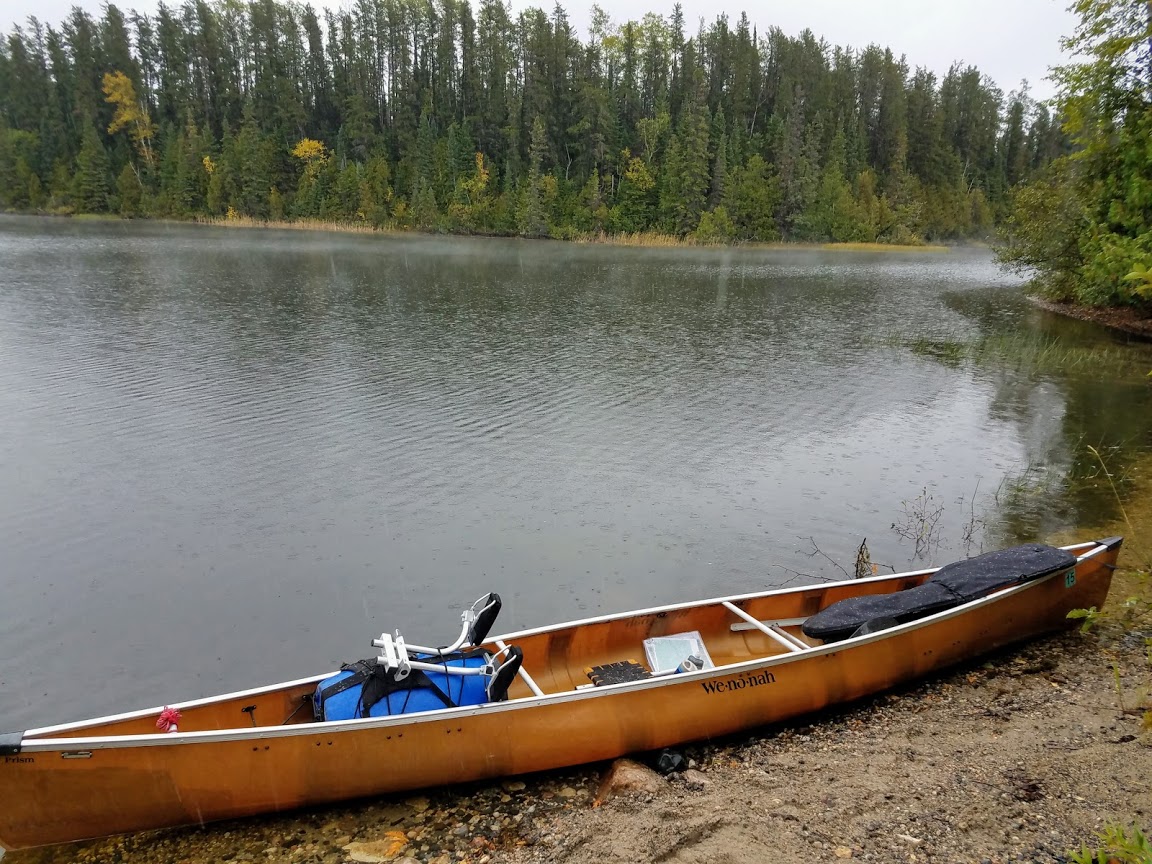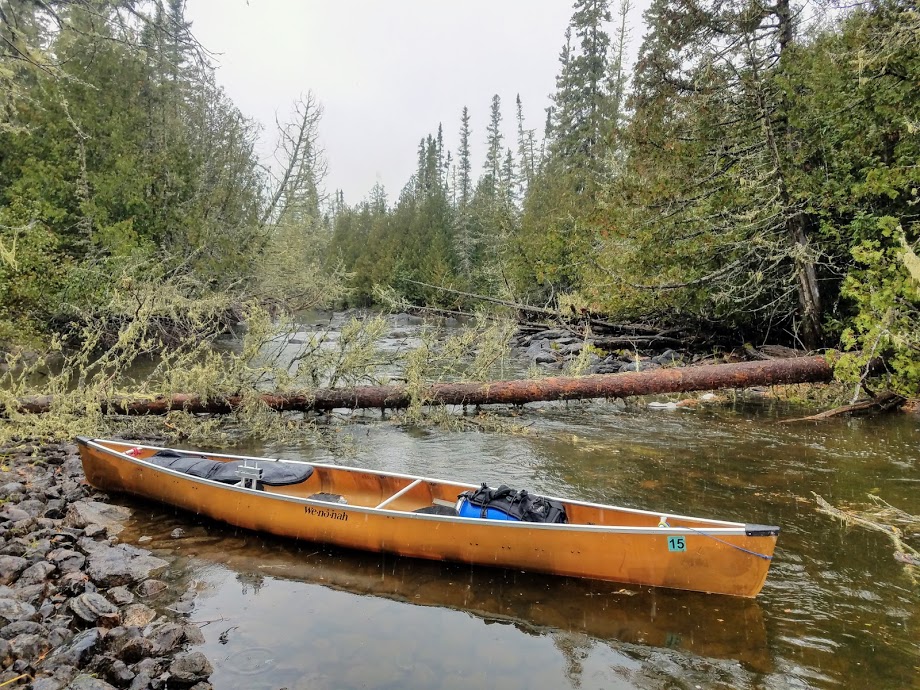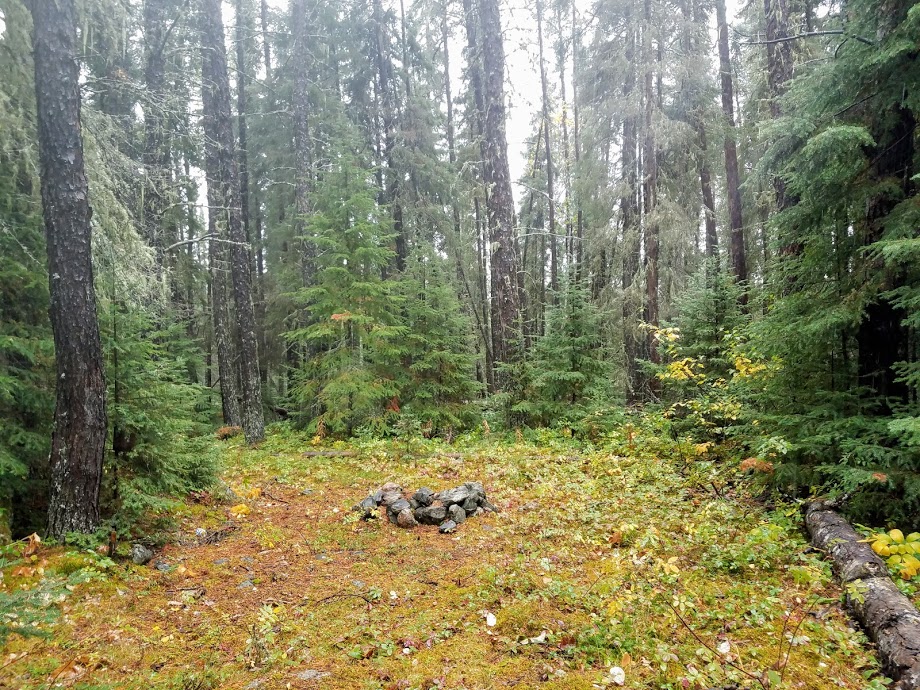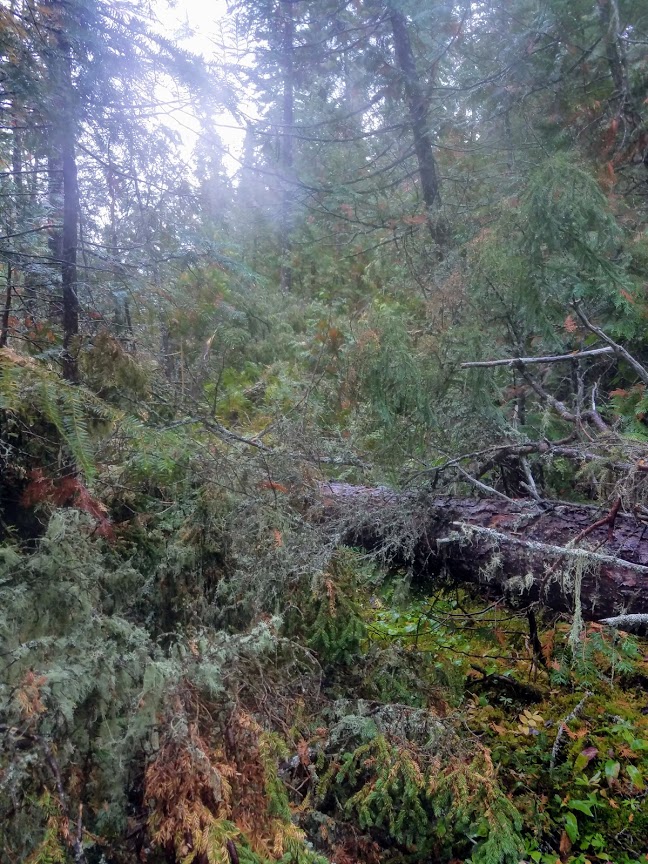Drowning River
by user0317
Trip Type:
Paddling Canoe
Entry Date:
09/21/2018
Entry & Exit Point:
Other
Number of Days:
8
Group Size:
1
Discuss Trip:
View Discussion Thread (15 messages)
Day 2 of 8
Saturday, September 22, 2018
Travelled 11.25 miles from Lower Twin Lake to east end of nameless lake (east of Wiggle Lake). I slept fitfully and woke up around 6am. I had a decent breakfast at the motel’s café and began the 1 hour drive up to Lower Twin Lakes Lodge in Nakina. Here I met John, the owner of Twin Lakes Lodge, who would drop me off at the beginning of the Drowning river as it exits the Twin Lakes, and pick me up at the end of my trip off a logging road near Supawn lake. The facilities at Twin Lake Lodge were clean and tidy, and I was happy that I’d be leaving my vehicle here rather than leaving it in the middle of the woods somewhere it could be vandalized or broken into during my absence.
It was a short drive to the river’s beginning and John dropped me off at about 10:30am. As soon as he left, it began to snow, and it would rain or snow for most of the next week. I knew that my Kevlar Wenonah Prism was not an ideal river-boat, being better suited for lake travel, so I did a few things to prepare it for downriver travel. I installed some lashing in both the bow and stern to secure my gear to the boat, to keep everything together in the event of a capsize. Additionally, I installed some painter-lines for lining the boat through rapids and around other obstacles.
Although I have owned the Prism for a few years, I have only paddled it on a few smaller lakes near my cabin in Northern Michigan, and this would be my first trip paddling it with a double-bladed paddle (Bending Branch Slice). The river started out wide and fairly calm, and I soon got a good pace going and found myself enjoying the new paddle. I was carrying a single-blade Wenonah Carbon paddle as a spare, which I never did use.
A little over a mile into the trip, I approached the first portage (P1 on the Greenstone map). The river was too shallow here to run through this rocky section, so I hopped into the water and lined my canoe through the rocks, bypassing the 215m portage. I had 2nd thoughts about getting into the water with it being so cold, but I knew that I’d have to get used to it.
Another hour or so of paddling, and I was ready to walk my first portage (P2). When I hit the trail I noted that snow was starting to accumulate in places, although the ground wasn’t quite frozen yet. I also noticed that I felt colder when I was portaging, then I did when I was paddling, which was consistent for me throughout this trip. I would often feel fine when I was in the canoe, even though I was soaking wet and it was in the 30s or low 40s, but I would shiver as soon as I was walking the portage. This was the opposite of what I would have expected.
Twenty minutes downriver I came across a tree blocking the river, requiring me to empty the canoe, move everything a meter across the tree, and then reload. It was a minor inconvenience and river trips tend to have unplanned obstacles like this (beaver dams, sweepers, boulder fields etc…). Another 10 minutes downriver and I reached P3, the ‘High Hill Portage’. As the name implies, the portage starts up a steep hill, which has a nice campsite in a stand of jack pines on the top. The hill has nothing on the portages that my canoe partner (Bobs) and I experienced earlier this year on the Steel River loop. The campsite sure looked inviting, but I had planned on making it at least to Wiggle Lake today, which was still a few miles downstream.
When I reached Wiggle Lake, I noticed that it sort of hung off to the side of the river route, so that one barely touches the lake if you just hop from the inlet to the outlet. There were no obvious campsites on this short section of shoreline, so I kept paddling, figuring that I’d find something further ahead. After a 100m portage, I soon found myself on a nameless lake, whose shape and size seemed to better justify the name ‘Wiggle Lake’ to me. Again, nothing on the shoreline was screaming ‘campsite’ to me, so I continued on to P5, figuring that I’d camp on the portage trail.
I reached P5 at about 3PM, and it was time to setup camp, eat dinner, and warm up. I portaged my gear across the portage, but had to clear out a 25m section of blowdown from the trail before I could get the canoe across. The heat is in the tools, as they say. With my gear across the portage, I decided to hang my hammock right across the trail’s end and get settled in. I boiled some water with the Biolite twig stove and made coffee and some pho noodles for dinner. I setup a clothes line before going to bed for the night, hoping that the rain/snow combination would quit and my clothes would dry out for the night. I slipped into my dry clothes, being careful not to get them wet before entering my hammock. I only had 2 full sets of clothing, except for socks, which I had 5 sets of. On the one hand, this seemed a bit stingy, but on the other hand, bringing more clothes would just result in me carrying more wet clothing around. Maybe 1 more set would have been handy.
Travelled 11.25 miles from Lower Twin Lake to east end of nameless lake (east of Wiggle Lake). I slept fitfully and woke up around 6am. I had a decent breakfast at the motel’s café and began the 1 hour drive up to Lower Twin Lakes Lodge in Nakina. Here I met John, the owner of Twin Lakes Lodge, who would drop me off at the beginning of the Drowning river as it exits the Twin Lakes, and pick me up at the end of my trip off a logging road near Supawn lake. The facilities at Twin Lake Lodge were clean and tidy, and I was happy that I’d be leaving my vehicle here rather than leaving it in the middle of the woods somewhere it could be vandalized or broken into during my absence.
It was a short drive to the river’s beginning and John dropped me off at about 10:30am. As soon as he left, it began to snow, and it would rain or snow for most of the next week. I knew that my Kevlar Wenonah Prism was not an ideal river-boat, being better suited for lake travel, so I did a few things to prepare it for downriver travel. I installed some lashing in both the bow and stern to secure my gear to the boat, to keep everything together in the event of a capsize. Additionally, I installed some painter-lines for lining the boat through rapids and around other obstacles.
Although I have owned the Prism for a few years, I have only paddled it on a few smaller lakes near my cabin in Northern Michigan, and this would be my first trip paddling it with a double-bladed paddle (Bending Branch Slice). The river started out wide and fairly calm, and I soon got a good pace going and found myself enjoying the new paddle. I was carrying a single-blade Wenonah Carbon paddle as a spare, which I never did use.
A little over a mile into the trip, I approached the first portage (P1 on the Greenstone map). The river was too shallow here to run through this rocky section, so I hopped into the water and lined my canoe through the rocks, bypassing the 215m portage. I had 2nd thoughts about getting into the water with it being so cold, but I knew that I’d have to get used to it.
Another hour or so of paddling, and I was ready to walk my first portage (P2). When I hit the trail I noted that snow was starting to accumulate in places, although the ground wasn’t quite frozen yet. I also noticed that I felt colder when I was portaging, then I did when I was paddling, which was consistent for me throughout this trip. I would often feel fine when I was in the canoe, even though I was soaking wet and it was in the 30s or low 40s, but I would shiver as soon as I was walking the portage. This was the opposite of what I would have expected.
Twenty minutes downriver I came across a tree blocking the river, requiring me to empty the canoe, move everything a meter across the tree, and then reload. It was a minor inconvenience and river trips tend to have unplanned obstacles like this (beaver dams, sweepers, boulder fields etc…). Another 10 minutes downriver and I reached P3, the ‘High Hill Portage’. As the name implies, the portage starts up a steep hill, which has a nice campsite in a stand of jack pines on the top. The hill has nothing on the portages that my canoe partner (Bobs) and I experienced earlier this year on the Steel River loop. The campsite sure looked inviting, but I had planned on making it at least to Wiggle Lake today, which was still a few miles downstream.
When I reached Wiggle Lake, I noticed that it sort of hung off to the side of the river route, so that one barely touches the lake if you just hop from the inlet to the outlet. There were no obvious campsites on this short section of shoreline, so I kept paddling, figuring that I’d find something further ahead. After a 100m portage, I soon found myself on a nameless lake, whose shape and size seemed to better justify the name ‘Wiggle Lake’ to me. Again, nothing on the shoreline was screaming ‘campsite’ to me, so I continued on to P5, figuring that I’d camp on the portage trail.
I reached P5 at about 3PM, and it was time to setup camp, eat dinner, and warm up. I portaged my gear across the portage, but had to clear out a 25m section of blowdown from the trail before I could get the canoe across. The heat is in the tools, as they say. With my gear across the portage, I decided to hang my hammock right across the trail’s end and get settled in. I boiled some water with the Biolite twig stove and made coffee and some pho noodles for dinner. I setup a clothes line before going to bed for the night, hoping that the rain/snow combination would quit and my clothes would dry out for the night. I slipped into my dry clothes, being careful not to get them wet before entering my hammock. I only had 2 full sets of clothing, except for socks, which I had 5 sets of. On the one hand, this seemed a bit stingy, but on the other hand, bringing more clothes would just result in me carrying more wet clothing around. Maybe 1 more set would have been handy.









 Donate - BWCA.com
Donate - BWCA.com